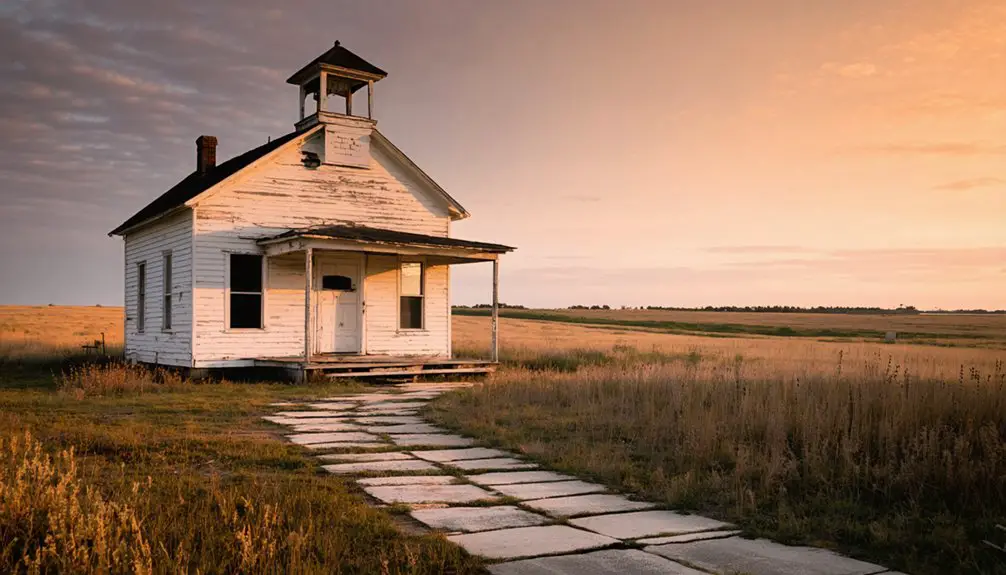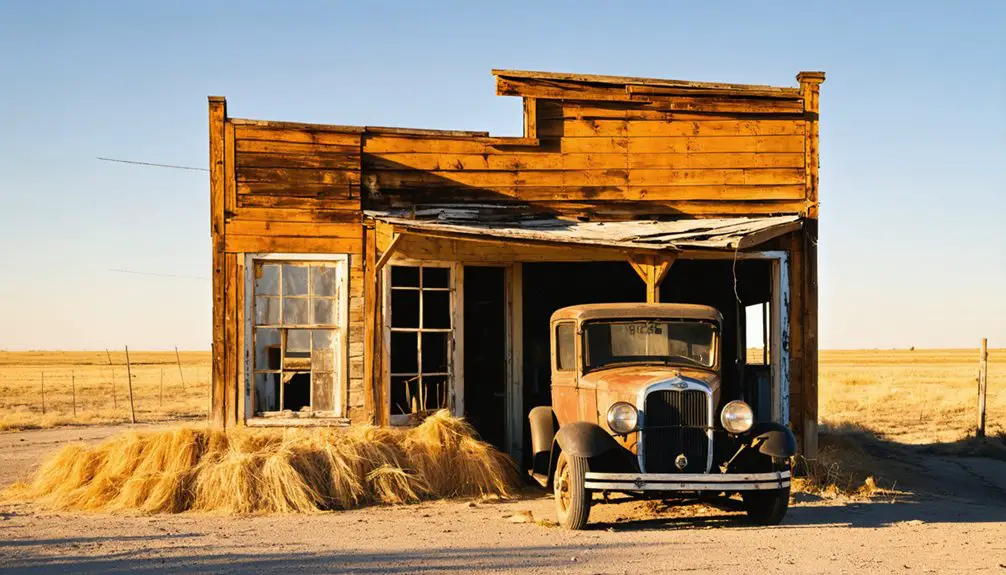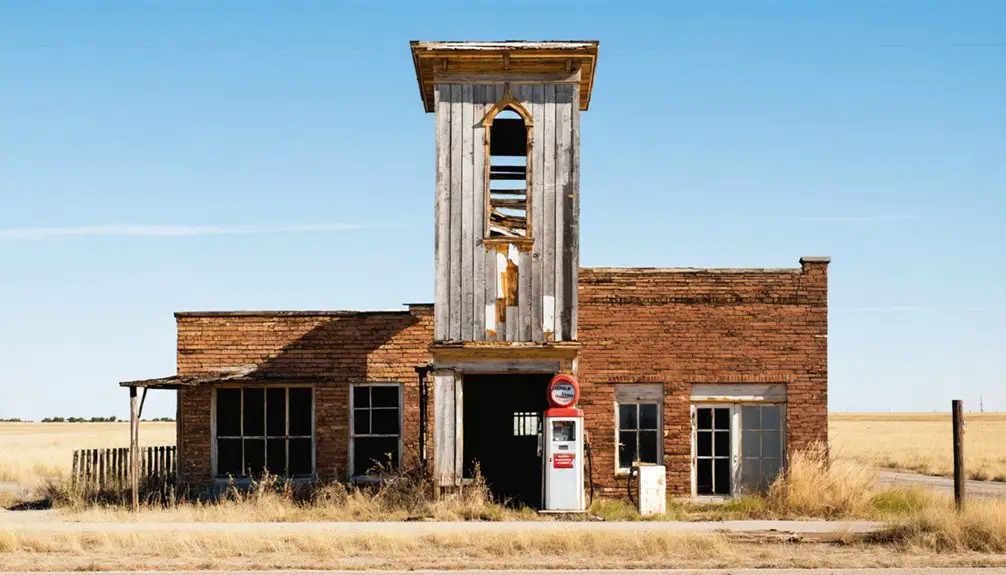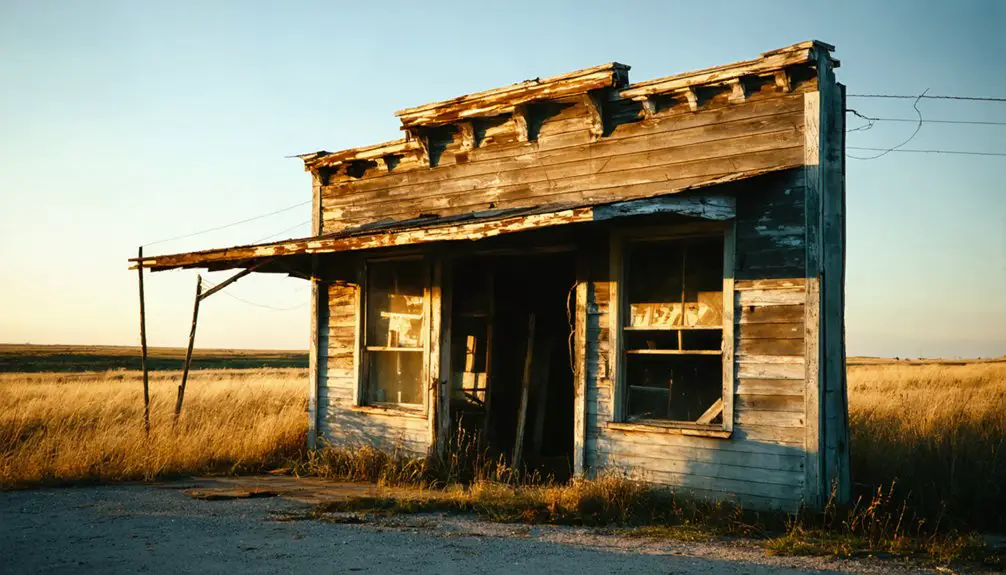You’ll find Lacey, Oklahoma’s ghost town roots in the 1889 Land Run, when thousands of hopeful homesteaders staked claims in the Unassigned Lands. Named after Congressman John F. Lacey, this once-thriving agricultural community flourished until the devastating Dust Bowl of the 1930s. Massive dust storms, plummeting crop prices, and widespread foreclosures forced most residents to abandon their farms. Today, weathered structures like the old schoolhouse and cotton gin tell stories of Lacey’s pioneering spirit and ultimate demise.
Key Takeaways
- Lacey originated during the 1889 Oklahoma Land Run but became a ghost town following the devastating Dust Bowl of the 1930s.
- The town lost over 80% of its population during mass exodus to California when agricultural conditions became unsustainable.
- Abandoned structures including a schoolhouse, cotton gin, and post office remain as physical remnants of the once-thriving farming community.
- Economic collapse occurred when agricultural earnings dropped 64% and massive dust storms destroyed farming operations.
- Dust storms reaching 30 feet high buried infrastructure and equipment, forcing residents to abandon their properties and livelihoods.
The Birth of a Prairie Settlement
When the Unassigned Lands opened for settlement on April 22, 1889, thousands of enthusiastic homesteaders rushed to stake their claims in what would become Lacey, Oklahoma.
You’ll find that these determined pioneers faced immediate settlement challenges as they transformed pristine prairie into viable farmland and established a community from scratch. Like David and Elizabeth Chambers who were early settlers in the Pacific Northwest, these Oklahoma homesteaders had to overcome significant obstacles to build their new lives.
Named after Congressman John F. Lacey of Iowa, the town quickly became a hub for claim registration, particularly when the federal land office opened to manage homestead claims. Similar to the Donation Land Claim Act of 1850 in the Pacific Northwest, this land registration process promoted American settlement of the frontier.
The pioneer struggles intensified as settlers contended with harsh prairie conditions while building homes, planting crops, and establishing essential services.
The town’s strategic location near the Chisholm Trail proved valuable, offering crucial trade connections that helped early residents overcome their initial hardships and build a thriving frontier community.
Early Pioneer Life and Cultural Diversity
The cultural tapestry of early Lacey emerged from a rich blend of Indigenous heritage and pioneering spirit. You’d have found the Nisqually and Squaxin Island peoples living sustainably off the land’s bounty, establishing deep connections to the south Puget Sound watershed that’d influence generations to come.
Pioneer traditions took root when families like the Chambers, Woods, and Ruddells arrived in the 1850s, bringing their diverse backgrounds from the East Coast and Midwest. Their cultural exchange with Indigenous peoples shaped the region’s character, though not without conflict. George W. Guthrie taught the first students in a modest log cabin schoolhouse built by local residents. The area’s growth mirrored the development seen in Ferrago Village, an early settlement that helped establish the region.
During the Indian War of 1855, you’d have witnessed settlers banding together for survival, fostering a tight-knit community centered around the first schoolhouse and Ruddell Pioneer Cemetery. These shared experiences created an enduring spirit of resilience that defined early Lacey’s social fabric.
Agricultural Roots and Community Growth
You’ll find that Lacey’s roots began with the Oklahoma Land Run of 1889, when immigrant farmers from Germany, Poland, Hungary, Russia, and England settled the fertile Unassigned Lands.
These pioneering families established modest farming operations adapted to the region’s hot summers and mild winters, focusing on sustainable crop production rather than industrial agriculture. Fred Kordis taught local children during the winter months when farming demands were lower. The area saw tremendous activity on Run of ’89 day when thousands of hopeful settlers gathered to stake their claims at noon on April 22, 1889.
The influx of diverse farming families shaped the young community’s growth, as they built supporting infrastructure including schools, churches, and businesses centered around agricultural commerce.
Early Settlement Patterns
Located within Oklahoma’s Unassigned Lands, Lacey’s settlement pattern emerged from the historic land run of April 22, 1889, as homesteaders rushed to stake their quarter-section farm claims.
The community dynamics quickly took shape as diverse immigrant farmers established their homesteads, creating a rich cultural tapestry that would define the region’s character.
Like many early Oklahoma towns that would later become ghost towns, Lacey’s development was driven by agricultural aspirations and the promise of new opportunities.
Similar to how towns like Burke City faced flooding disasters, Lacey’s farmers endured numerous environmental challenges throughout their settlement years.
Key settlement patterns that shaped Lacey’s early development:
- Quarter-section farm claims formed the backbone of the community’s agricultural layout.
- Immigrant clusters of German, Polish, Hungarian, Russian, and English settlers created tight-knit farming neighborhoods.
- Local land offices managed claim registration to guarantee orderly development.
- Schools and churches emerged as central gathering points, strengthening community bonds.
These settlement patterns laid the foundation for Lacey’s growth as a farming community, though they’d later face significant challenges during the Dust Bowl era.
Immigrant Farming Communities
During the turbulent 1930s, Lacey’s immigrant farming communities underwent dramatic transformations as the Dust Bowl pushed many tenant farmers westward, particularly to California’s San Joaquin Valley.
You’ll find that these families, who’d built their lives around Lacey’s agricultural economy, joined the massive exodus along Route 66, seeking work in distant fields. Their cultural heritage, deeply rooted in Oklahoma’s soil, traveled with them as they adapted to life as migrant labor. Many families found themselves living in makeshift resettlement camps established by the federal government. The arrival of these migrants, often pejoratively called Okies, sparked hostility from local residents.
Those who remained in Lacey struggled to maintain their farms amid harsh conditions, while watching their neighbors depart for promised opportunities in Arizona’s cotton fields or California’s fertile valleys.
The town’s farming legacy shifted as federal programs, including the later Bracero Program, brought new waves of agricultural workers who’d reshape the region’s cultural landscape.
Local Crop Production
Roots of Lacey’s agricultural heritage trace back to the 1889 Unassigned Lands opening, when pioneering farmers first broke the prairie soil with steel plows and mechanical reapers.
You’ll find that early settlers embraced crop innovations and farming techniques that shaped the region’s agricultural success.
The community’s farming prowess developed through:
- Production of 8.6 million bushels of wheat and 113 million bushels of corn by 1907
- Cultivation of cotton yielding 864,000 bales during peak seasons
- Cooperative equipment sharing among farmers who couldn’t afford their own machinery
- Adaptation of drought-resistant practices to combat harsh weather conditions
Despite initial skepticism toward mechanization, Lacey’s farmers eventually adopted modern equipment, though tractors didn’t become common until after 1945.
The shift from horse-drawn implements to powered machinery marked a turning point in local agricultural efficiency.
Education and Social Institutions

Education in Lacey initially depended on traveling instructors like Fred Kordis, who served the community’s immigrant farming families through seasonal teaching circuits.
You’ll find he’d stay six weeks at a time, primarily teaching during winter months when farming demands eased. Despite educational challenges, the town later established its own schoolhouse, reflecting the community’s commitment to learning.
Teachers adapted to farming rhythms, staying briefly during winter’s quiet to educate rural children before moving to the next community.
The school and churches formed the backbone of social life, bringing together families from German, Polish, Hungarian, Russian, and English backgrounds.
You’ll see evidence of this in the remaining school and gymnasium structures, which hosted community gatherings and athletic events.
While the Dust Bowl and Depression drove many residents away, including educators like Kordis, some returned, demonstrating their dedication to Lacey’s educational future.
The Harsh Reality of the Dust Bowl Years
As massive dust storms swept across Lacey in the 1930s, the town’s residents faced an unprecedented environmental catastrophe that would forever alter their community.
The relentless dust storms and severe soil erosion transformed the once-fertile farmland into an uninhabitable wasteland. You’d have witnessed:
- Dust drifts up to 30 feet high burying fences, farm equipment, and buildings
- Agricultural yields plummeting as 850 million tons of topsoil vanished from the region
- Families battling “dust pneumonia” and other respiratory ailments from hazardous air quality
- Native grasslands destroyed, with wildlife populations like prairie chickens and pronghorn antelope declining dramatically
These harsh conditions ultimately forced many of Lacey’s residents to abandon their homes and farms, contributing to the town’s eventual transformation into a ghost town.
The devastating impact of soil erosion and dust storms left an indelible mark on the community’s history.
Impact of the Great Depression

The Great Depression struck Lacey with devastating force, as plummeting crop prices forced many farmers to mortgage or abandon their land despite their continued efforts to cultivate.
You’d find that by the 1930s, most of Lacey’s residents had joined the mass exodus westward to California, where they sought work in agricultural labor camps and lived in converted boxcars.
The town’s population loss was staggering, matching the pattern of comparable Oklahoma farming communities that experienced 80% or greater decline during this period.
Economic Hardship Hits Home
When the Great Depression struck Oklahoma in 1929, Lacey faced devastating economic upheaval that would forever alter its trajectory. Your community’s economic resilience was tested as the crisis deepened, revealing the harsh realities of rural Oklahoma life.
Here’s what you’d have witnessed in Lacey during those trying times:
- Local banks collapsed, wiping out your neighbors’ life savings as over 200 Oklahoma banks failed.
- Farm prices plummeted – cotton dropped to 6¢/lb and wheat to 38¢/bushel – leaving you unable to cover basic expenses.
- More than 60% of tenant farmers lost their livelihoods, forcing many to abandon their homes.
- Makeshift soup kitchens emerged as community solidarity became essential for survival.
Despite Governor Murray’s declaration of martial law to halt foreclosures, Lacey’s economic foundation continued to crumble under the weight of this unprecedented crisis.
Mass Exodus Begins
During the darkest days of the Great Depression, Lacey’s once-vibrant community began unraveling as desperate families packed their belongings and joined the mass exodus west.
You’d have witnessed entire families – German, Polish, Hungarian, Russian, and English descendants – abandoning their farms and heading to California, where they’d face harsh migration challenges living in makeshift camps and converted boxcars.
Despite their community resilience, tenant farmers, who made up over 60% of the population, were hit hardest by foreclosures and plummeting farm incomes.
With agricultural earnings down 64% and oil prices collapsing, there wasn’t much keeping folks in Lacey.
The lack of public welfare left these families with few options, and as they scattered across the country seeking seasonal work, the social fabric that had bound this diverse farming community together began to tear apart.
Notable Structures and Remnants
Scattered across Lacey’s abandoned townsite, notable structures and remnants provide tangible links to its bustling past. As you explore these ghostly landmarks, you’ll discover architectural remnants that tell the story of a once-thriving Oklahoma community.
The town’s skeletal framework reveals its former prominence through:
- A weather-worn wooden schoolhouse with crumbling walls and broken windows, standing as a silent symbol of the community’s educational heritage.
- The rusted remains of the old cotton gin, marking Lacey’s agricultural prosperity.
- A partially intact post office building with its faded facade, where townsfolk once gathered to collect mail and share news.
- An overgrown cemetery on the town’s outskirts, where weathered headstones chronicle the lives of early settlers and their descendants.
Legacy of a Lost Community

Beyond the physical remnants that dot Lacey’s landscape, the town’s true legacy lives on through its remarkable cultural tapestry and enduring impact on Oklahoma’s history.
You’ll find evidence of community resilience in the stories of diverse immigrant settlers – German, Polish, Hungarian, Russian, and English families – who forged a vibrant farming community despite tremendous odds. Their cultural heritage shaped the region’s early development, establishing a rich agricultural tradition that defined Lacey’s identity.
When the combined forces of the Dust Bowl and Great Depression struck, many residents demonstrated extraordinary adaptability, temporarily relocating to California yet maintaining deep connections to their Oklahoma roots.
Lacey’s story exemplifies the broader narrative of rural Oklahoma communities and their remarkable capacity to preserve their heritage even in the face of environmental and economic devastation.
Exploring Lacey Today
Today’s visitors to Lacey encounter a quiet tribute to Oklahoma’s rural past, where remnants of a once-thriving farming community persist along State Highway 51.
For ghost town exploration enthusiasts, the site offers glimpses into early 20th-century rural life through its weathered structures and historical preservation challenges.
When planning your visit, keep in mind these essential details:
- Best access is during spring and fall months, avoiding extreme summer heat
- The gas station, school, and gymnasium remain visible but unstable
- Pack necessary supplies as no facilities exist on-site
- Standard vehicles can navigate the 2WD roads from Hennessey
While Lacey lacks the toxic cleanup issues of Oklahoma’s mining ghost towns, the harsh climate continues to impact the remaining structures, making each visit a unique window into the state’s agricultural heritage.
Frequently Asked Questions
Are There Any Paranormal Activities Reported in Lacey’s Abandoned Buildings?
You’ll find reported ghost sightings in the abandoned gas station, school, and gymnasium, though limited documentation exists. These haunted locations feature unexplained sounds, moving objects, and shadowy figures darting through rooms.
What Happened to the Cemetery and Burial Records From Lacey?
Time has swallowed the cemetery whole, with weeds and wildlife taking over. You’ll find most burial records are lost, though local volunteers occasionally attempt cemetery restoration and burial record preservation projects.
Is It Legal to Visit and Photograph the Remaining Structures?
You’ll need landowner permission since most structures are on private property. Follow photography guidelines carefully – shooting from public roads is legal, but entering buildings without authorization risks trespassing charges.
Were There Any Notable Crimes or Outlaws Associated With Lacey?
As you explore the quiet farmland where Lacey once thrived, you’ll find no trace of outlaw legends in its history. The town’s agricultural roots steered clear of criminal notoriety.
Do Any Descendants of Original Lacey Settlers Still Own Property There?
You won’t find verified descendant ownership records from original settlers – available documentation doesn’t confirm any continuous family property claims, though some historical preservation efforts track abandoned Lacey structures and lands.
References
- https://echo.snu.edu/the-ghost-towns-of-oklahoma/
- https://en.wikipedia.org/wiki/List_of_ghost_towns_in_Oklahoma
- https://www.okhistory.org/publications/enc/entry?entry=GH002
- https://www.ghosttowns.com/states/ok/lacey.html
- https://kids.kiddle.co/List_of_ghost_towns_in_Oklahoma
- https://envisiontomorrowlacey.org/history-profile/
- https://laceyparks.org/lacey-museum/learn-about-laceys-history/
- https://www.okhistory.org/about/markers?action=Search&county=Kingfisher
- https://www.nps.gov/jeff/planyourvisit/settlement-of-the-southern-plains.htm
- https://tulsahistory.org/exhibit/becoming-tulsa-cultivating-city-life-from-a-prairie-town-1878-1900/



